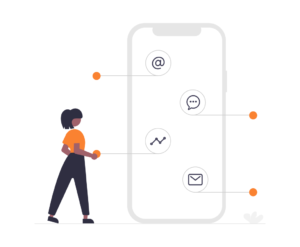
(Intro) How To Build An App
Given the hundreds of thousands of mobile apps that exist today, there are no secrets on how to build a mobile app. This definitive guide will walk you through everything you need to know from ideation to scaling. If you need any additional help, you can always consult professional app builders.
Generating App Ideas
The first step in how to build a successful app is coming up with a great idea. There are a few techniques you can use to generate unique and innovative app ideas:
- Identify a problem or need in the market – Look at your own experiences and think about daily frustrations, inconveniences or needs that aren’t being met. Talk to people in your target market and research online to find common problems an app could solve.
- Explore remix techniques – You don’t always have to start from scratch. Look at existing popular apps and think about how you could add new features, combine concepts or improve the user experience. Putting a fresh spin on an existing idea can lead to an exciting new app.
- Scratch your own itch – Think about a solution for one of your own needs or problems. Chances are if you have a particular pain point, many others likely do as well. Build an app that you yourself would use and enjoy.
- Leverage trends – Look at rising trends and technologies to inspire new app ideas. For example, augmented reality is gaining popularity, which creates opportunities for innovative AR apps.
- Utilise app idea generators – There are many app idea generator tools online that can help spark initial ideas through random word combinations and idea prompts. They can help get your creative juices flowing.
The key is coming up with an app idea that is relatively unique, solves a real problem for users, and has significant market demand. With some brainstorming and creativity, you can generate the next big app idea.
Market Research: Analysing the Competition

Conducting thorough market research is a crucial step before building your app. This involves studying your competitors and existing apps in the market, identifying gaps and areas for improvement, and assessing market demand for your app idea.
- Carefully analyse the top apps in your category on both the App Store and Google Play. Download the apps and use them extensively. Make a list of all the features and functionality offered. Look for common themes and standout capabilities.
- Identify direct and indirect competitors. Direct competitors offer very similar core functionality. Indirect competitors may solve the same user problem in a different way. Evaluate both types of apps to learn best practices.
- Look for gaps in competitor offerings that your app could potentially fill. For example, you may find that existing apps lack certain features, have unintuitive interfaces, or fail to appeal to certain demographics.
- Assess the market demand and target user base for your app idea. Research the size of your target audience. Conduct surveys to gauge interest in your app’s proposed features and value proposition.
- Estimate the total addressable market (TAM) for your app category. Factor in platform differences between iOS and Android when sizing your potential market.
- Review app store reviews and feedback for competing apps. Look for common complaints and pain points your app could improve upon.
- Sign up for related industry newsletters, blogs, communities, and events to better understand trends and innovations in your niche.
- Leverage tools like Google Trends, Facebook Audience Insights, and Alexa to analyse search volume and demand for related keywords.
Thorough market research will help validate your app idea, shape the feature roadmap, and inform an effective go-to-market strategy. Continuously analyse the competitive landscape even after launching your app.
Defining Features: Outlining Core Functionality
The next step after researching the market and competition is to define the core features and functionality for your minimum viable product (MVP). Your MVP should focus on solving the core user problem and delivering baseline functionality with the smallest possible feature set.
When deciding on your MVP features, prioritise must-have features over nice-to-haves. The essential features are ones that directly address the user needs you identified during market research. Nice-to-have features can wait for future releases after you have validated your MVP with users.
Some best practices for prioritising MVP features when building a mobile app include:
- List out all possible features and functionality for your app
- Classify features as essential, important, or nice-to-have
- Focus on the riskiest assumptions and validate those first
- Determine the easiest way to address the core user need
- Seek user feedback early and often to confirm priority features
- Limit features to only what is absolutely necessary for launch
Once you have defined your initial MVP feature set, you can start planning for future expansions and updates. Maintain a feature backlog of nice-to-haves, stretch goals, and new ideas. Prioritise features in your backlog based on user feedback, market demand, and resources available.
Aim to expand your feature set incrementally by releasing new versions. This allows you to validate each new feature with users before moving on to build more. Releasing early and often ensures you are aligned with real user needs versus overbuilding features users may not want.
By focusing on the essentials for your MVP and planning future feature expansions strategically, you can build an app that solves real problems for users while adapting to market feedback.
Wire-framing and Prototyping

Wire-framing and prototyping are critical steps in the app design process that allow you to map out the structure and functionality of your app before writing any code. Wireframes are basic visual layouts that outline the interface, content, and functionality on each screen. Prototypes take this a step further by simulating interactions and allowing you to test user flows.
There are many tools available for creating wireframes and prototypes, ranging from paper and pencil to sophisticated software like Figma, Adobe XD, InVision Studio, and more. Here are some best practices when creating wireframes and prototypes:
- Focus on content structure, layout, and priority. Don’t get distracted by colors, fonts, etc.
- Map out the app flow screen-by-screen and include each interaction.
- Design with mobile in mind. Adhere to platform conventions and ensure usability on small screens.
- Create clickable prototypes to simulate interactions and test if the app flow makes sense.
- Design multiple variations of key screens to evaluate different options.
- Validate concepts with target users early and often to get feedback.
- Maintain consistency across screens and elements to avoid confusing users.
- Ensure accessibility considerations are incorporated from the start.
- Collaborate with stakeholders, designers and developers to align on direction.
Well-executed wireframes and prototypes ensure you identify and fix UX issues early before costly development begins. They also provide the visual blueprint for developers to code against, improving efficiency and quality. Investing time upfront in wire-framing and prototyping can vastly improve your end product.
UX/UI Design

A well-designed user interface is critical for any successful app. The user experience (UX) and user interface (UI) design encompasses both the visual design as well as the overall usability and flows within the app. Here are some key best practices for crafting an exceptional UX/UI:
- Use a clean, intuitive layout with ample white space. Avoid overcrowding the interface.
- Employ visual hierarchy through strategic use of fonts, colours and element sizing. Draw attention to key actions.
- Choose a minimalist colour scheme with 2-3 colours. Vibrant accents can highlight interactive elements.
- Implement responsive design for a flawless experience across mobile devices. Test on various screen sizes.
- Use interface elements users are familiar with, such as tabs, toggles and scrolling. Don’t reinvent the wheel.
- Ensure text is legible, with good contrast against backgrounds. Typography should be consistent.
- Design for thumb-friendly interactions based on mobile ergonomics. Place key buttons within easy reach.
- Provide clear calls-to-action for conversions, from signup to purchases. Visual cues guide users.
- Craft pleasing custom iconography that conveys meaning at a glance. Illustrations can enhance branding.
- Animate transitions and micro-interactions for delight. Feedback indicates results of actions.
- Follow platform-specific interface guidelines for optimal UX. Differentiate iOS and Android patterns.
- Conduct usability testing to identify pain points and refinement opportunities. Iterate based on feedback.
With thoughtful UX/UI design centered on the user, your app will provide a seamless and satisfying experience driving adoption, engagement and conversions.
Development Approach: Native, Web, or Hybrid?

When it comes to building your app’s front-end, you have three main options: native app development, progressive web apps (PWAs), or hybrid app development. Each approach has its own pros and cons.
Native App Development
Native app development produces apps tailored specifically for one platform, like iOS or Android. Native apps can access all of the device features like the camera, GPS, push notifications etc. They also tend to have the best performance, responsiveness, and overall user experience.
The downside is you have to build the iOS and Android versions separately, which takes more time and resources. You’ll need to code in Swift/Objective-C for iOS and Java/Kotlin for Android.
Progressive Web Apps (PWAs)
PWAs are web apps that use modern web capabilities and APIs to deliver an app-like experience. PWAs run cross-platform and can work on iOS, Android, desktop etc.
The main advantage of PWAs is you only have to build once. They also require less development effort than native apps. On the other hand, PWAs can’t access all native device capabilities and tend to have worse performance than native apps.
Hybrid App Development
Hybrid apps use web technologies like HTML, CSS and JavaScript but run those web apps inside native app wrappers. This allows accessing some native features while reducing overall development effort.
Performance and user experience is better than PWAs but still falls short of native apps. You’ll need knowledge of web development as well as platforms like React Native or Flutter.
No-Code App Builders
For non-technical founders, no-code app builders like Bubble allow creating apps visually without coding. This greatly speeds up development but flexibility is lower compared to traditional coding. You may still need a technical co-founder to handle complex integrations or customisations.
Overall, weigh your resources, timeline, and app requirements when deciding on the best development approach. A basic PWA or no-code app can work for launching an MVP quickly. For more complex apps with native capabilities, native development is preferable.
Quality Assurance
Thorough testing is crucial to ensure your app functions properly across different devices, platforms, and operating system versions. Set up a comprehensive testing plan and test cases to cover the key functionality and user flows in your app.
Test on Real Devices
In order to ensure the highest levels of quality assurance, test the app on both iOS and Android physical devices. Within each platform, ensure compatibility with various models and screen sizes – for example, test on both iPhones and iPads for iOS. Try to get access to both older and newer devices to test a range of OS versions.
Identify Bugs and Crashes
Rigorously test all features and user flows to identify any bugs, crashes or error messages. Isolate the root cause of issues and fix them methodically. Pay special attention to forms, payment gateways and key integrations.
Get User Feedback
Conduct user testing by having a set of representative users try out your app. Observe how they navigate the app and where they face confusion or friction. Incorporate feedback to refine the UX and UI.
Check Performance
Evaluate app speed, responsiveness, loading times, and data and battery usage. Optimise images and remove unnecessary libraries to improve performance. Test on both WiFi and cellular data.
Security and Compliance
Perform security testing of authentication, data transmission and storage. Check for vulnerabilities like SQL injection or cross-site scripting. Also ensure legal and regulatory compliance. You’ll also want to follow all the steps to make sure you legally own your app.
Iterate and Retest
With every new feature or major update, regression test your app thoroughly. Fix newly introduced bugs promptly. Automated testing can help scale your testing efforts.
Launch Preparation

After building a mobile app, a successful app launch requires thoughtful preparation and planning. Here are some key steps to optimise your launch:
App Store Optimisation
- Craft an engaging app title and description for the store listings. Highlight the key benefits and value proposition.
- Include relevant keywords in the metadata, but avoid keyword stuffing.
- Prepare high-quality app screenshots and videos that showcase the UI and core features.
- Make sure the app icon is visually appealing and reflects the brand.
Promotion Strategy
- Develop a pre-launch buzz on social media to start building anticipation.
- Identify influencers, bloggers, and media outlets that align with your target audience. Reach out for reviews and coverage.
- Consider paid user acquisition strategies like social media ads and app store ads.
- Plan PR outreach to tech publications and build relationships with journalists.
- Prepare launch discount promotions or special offers to incentivise early adopters.
- Time your launch to capitalise on relevant events, conferences, or seasonal demand.
Launch Day Execution
- Publish your app on the store and make it live for users to download.
- Activate your promotion strategies and marketing campaigns.
- Closely monitor downloads, user feedback, reviews, and performance metrics.
- Respond promptly to reviews, fix critical bugs, and release updates as needed.
With robust pre-launch planning and an effective launch strategy, you can set your app up for success right from day one.
Post-Launch: Maintenance and Updates

Once your app is live in the app stores, the work doesn’t stop there. You need to closely monitor your app’s performance and user feedback, and continuously release updates to improve the user experience. Support and maintenance should be planned for in advance.
Monitor Performance
Implement analytics tools like Google Analytics and App Annie to track key metrics like downloads, activations, retention, and revenue. Set up custom dashboards to monitor user behaviour and pinpoint areas for optimisation. Stay on top of reviews and feedback from users to identify pain points.
Release Regular Updates
Schedule frequent updates to fix bugs, add features, and improve performance. Prioritise updates based on user feedback and data insights. Release iterative updates often instead of waiting months between major releases. Updates show users that the app is being maintained and improved over time.
Optimise User Engagement
Analyse user cohorts to understand behaviours of highly engaged users vs. less engaged ones. Run A/B tests to optimise onboarding, UI, notifications, etc. to drive better engagement. Leverage push notifications and emails judiciously to re-engage lapsed users. Continuously refine your monetisation strategies as well. Whether your app is free or paid, there are many strategies to ensure your app makes money.
The key is to not treat launching as the finish line. You need to iteratively improve the app over time through a data-informed process of constant monitoring, testing and optimising. Active development and innovation will help your app stand out in a competitive landscape.
Marketing and User Acquisition

You may have followed all the steps on how to build a mobile app, but now the world needs to hear about it. Marketing and user acquisition are critical to getting your app discovered and driving downloads. Here are some key strategies:
Leverage Social Media
- Create social media profiles for your app on platforms like Facebook, Instagram, Twitter, etc.
- Run targeted ads on social media to reach your ideal audience
- Engage with users by sharing app updates, contests, etc. on social channels
- Reach out to relevant influencers and bloggers to get coverage of your app
Optimise for App Store Search
- Research relevant keywords and optimise your app store listing for them
- Include keywords in your app name, description, and other metadata
- Get reviews and ratings to boost your ranking in search results
Run App Install Ads
- Create ads on platforms like Facebook, Instagram, Google, etc. promoting app installs
- Target users who are likely to be interested in your app category
- Test different creatives, messaging, audiences to optimise performance
PR and Media Outreach
- Identify relevant publications and pitch your app story to them
- Offer exclusive access or content to secure coverage
- Time your PR efforts around key milestones like launch
Build an Email List
- Offer incentives for users to share their email address
- Send out updates, offers, and news to build engagement
Attend Relevant Events
- Events like conferences and meetups are great for networking
- Look for speaking opportunities to promote your app
Influencer Marketing
- Reach out to influencers who align with your brand
- Provide free access to your app in return for reviews and promotion
Continuously Experiment
- Test different channels and strategies to see what gives the best ROI
- Analyse and double down on tactics that drive real app installs
